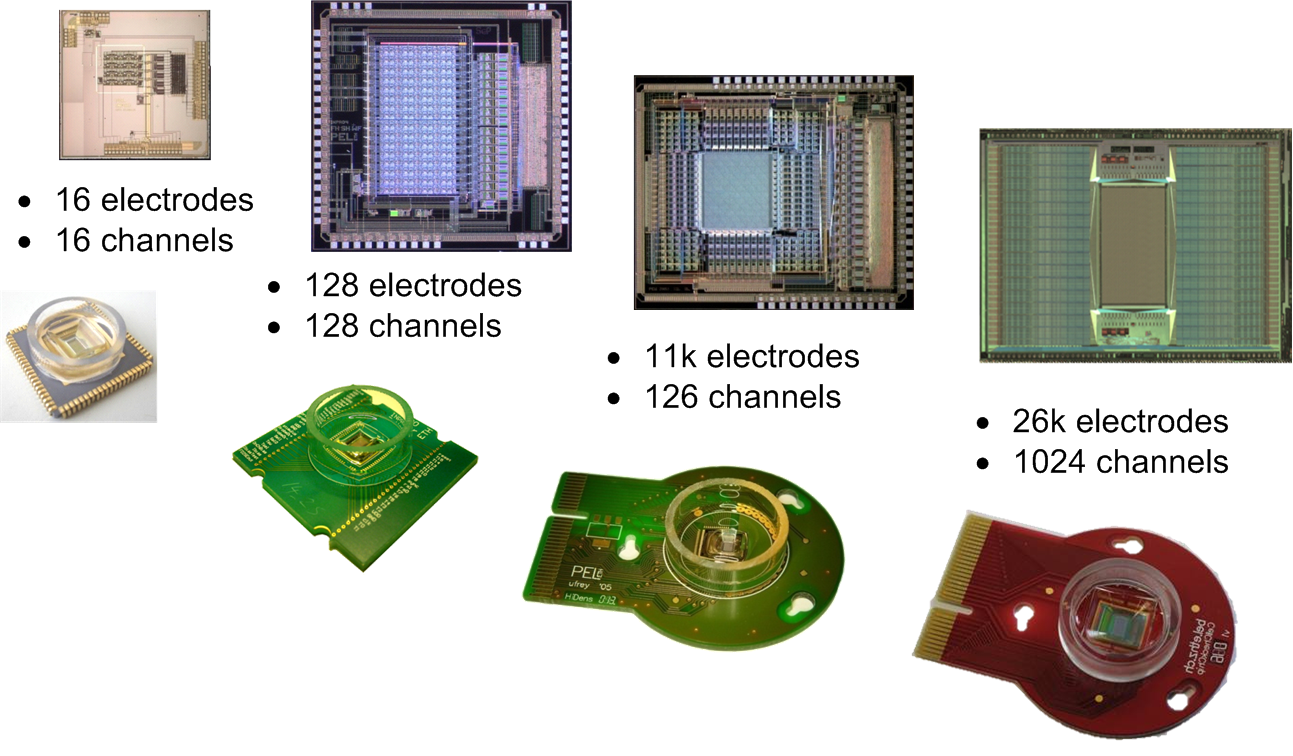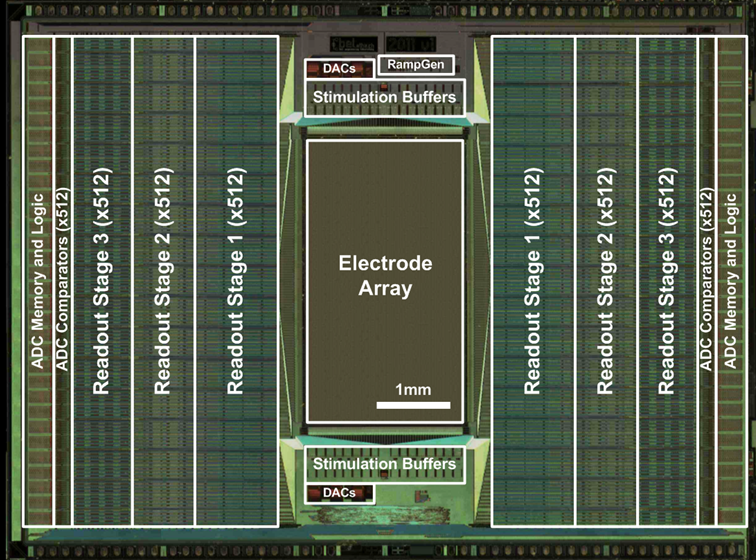Microelectrode Systems
Traditional external pagemicroelectrode arrayscall_made (MEAs) are circuitless chips carrying arrangements of usually 60 electrodes that are used for multisite extracellular recording from electrogenic cells, such as neurons or heart cells. They are used in the fields of neuroscience and biosensing, to study fundamentals of neuronal information processing, of learning processes, of aging and mental diseases, or to assess the behavior of electrogenic cells upon exposure to pharmacological agents or hazardous substances.
The development and use of CMOS-based devices can overcome limitations of passive MEAs, in particular with respect to performing measurements at high spatial and temporal resolution at excellent signal quality. Through on-chip signal multiplexing, a large number of electrodes can be addressed to achieve a high spatio-temporal resolution in recording and stimulation scenarios. Moreover, weak neuronal signals can be conditioned right at the electrodes by dedicated circuitry units, which provide a large signal-to-noise ratio. Finally, analog-to-digital conversion is performed on chip, so that only stable, digital signals are transmitted.
Several CMOS-based MEAs have been developed at our lab during the past years. We currently focus on high-density arrays of thousands of electrodes (> 11,000) for electrophysiological recordings at subcellular resolution (17 μm electrode pitch, 5 - 8 μm electrode diameter, 3,150 electrodes per mm²) in active areas between 2 x 2 mm² and 2 x 4 mm².
Recent publications
X. Yuan, A. Hierlemann, U. Frey, "Extracellular recording of entire neural networks using a dual-mode microelectrode array with 19,584 electrodes and high SNR", IEEE Journal of Solid-State Circuits 2021, in press (DOI: 10.1109/JSSC.2021.3066043). external pageOnlinecall_made
X. Yuan, M. Schröter, M. Engelene J. Obien, M. Fiscella, W. Gong, T. Kikuchi, A. Odawara, S. Noji, I. Suzuki, J. Takahashi, A. Hierlemann, U. Frey, "Versatile live-cell activity analysis platform for characterization of neuronal dynamics at single-cell and network level", Nature Communications 2020, 11, 4854 (DOI: 10.1038/s41467-020-18620-4). external pageOnlinecall_made
A. Shadmani, V. Viswam, Y. Chen, R. Bounik, J. Dragas, M. Radivojevic, S. Geissler, S. Sitnikov, J. Müller, A. Hierlemann, "Stimulation and artifact-suppression techniques for in-vitro high-density microelectrode array systems", IEEE Transactions on Biomedical Engineering, 2018, in press (DOI: 10.1109/TBME.2018.2890530). external pageOnlinecall_made
V. Viswam, R. Bounik, A. Shadmani, J. Dragas, C. Urwyler, J. Boos, M. Obien, J. Müller, Y. Chen, A. Hierlemann, "Impedance spectroscopy and electrophysiological imaging of cells with a high-density CMOS microelectrode array system", IEEE Trans. Biomed. Circuits Syst. 2018, 12 (6), pp. 1356-1368 (DOI: 10.1109/TBCAS.2018.2881044). external pageOnlinecall_made
J. Dragas, V. Viswam, A. Shadmani, Y. Chen, R. Bounik, A. Stettler, M. Radivojevic, S. Geissler, M. Engelene J. Obien, J. Müller, A. Hierlemann, "In-vitro multi-functional microelectrode array featuring 59760 electrodes, 2048 electrophysiology channels, stimulation, impedance measurement and neurotransmitter detection channels", IEEE Journal of Solid-State Circuits, 2017, Volume 52 (6), pp. 1576-1590 (DOI:10.1109/JSSC.2017.2686580). external pageOnlinecall_made


